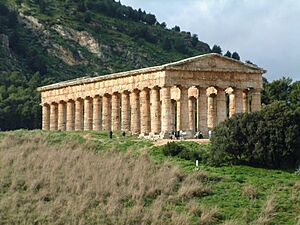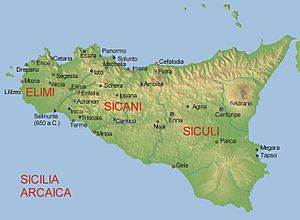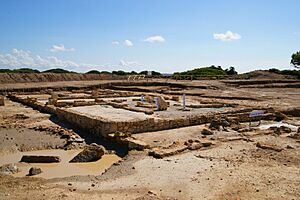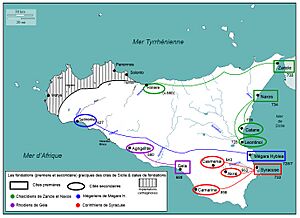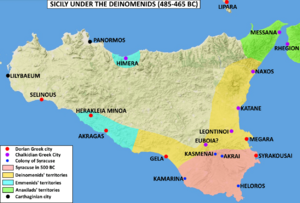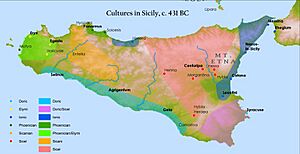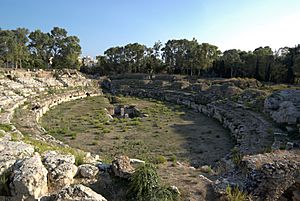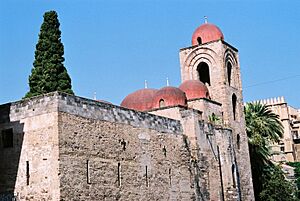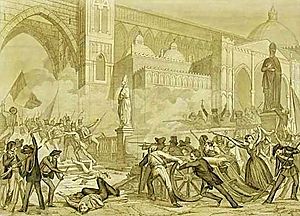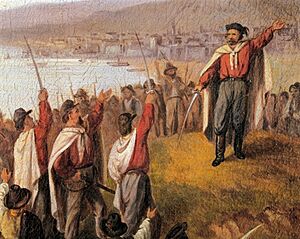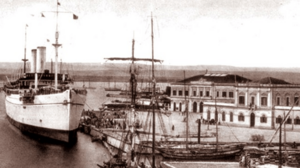History of Sicily facts for kids
The history of Sicily is a long story of many different groups of people living on and ruling the island. Sicily has been controlled by various powers, including the Phoenicians, Carthaginians, Greeks, Romans, Vandals, Ostrogoths, Byzantines, Arabs, Normans, Aragonese, Spanish, Austrians, and British. However, Sicily also had important times of independence. This happened under its first people like the Sicanians, Elymians, and Sicels. Later, it was independent as the County of Sicily and the Kingdom of Sicily.
The Kingdom of Sicily was started in 1130 by Roger II of Sicily, a Norman ruler. During this time, Sicily was very rich and powerful. It became one of the wealthiest places in all of Europe. Later, the island came under the rule of the Hohenstaufen family. At the end of the 13th century, after a big war called the War of the Sicilian Vespers, Sicily became part of the Crown of Aragon. In the centuries that followed, the Kingdom of Sicily was linked to the Spanish and Bourbon crowns, but it stayed mostly independent until 1816. Sicily then joined the Kingdom of Italy in 1861.
Today, Sicily is a special autonomous region of Italy. It has its own unique culture. Sicily is the largest region in Italy and the biggest island in the Mediterranean Sea. Its central location and natural resources made it a very important place for trade routes across the Mediterranean. Famous people like Cicero and Muhammad al-Idrisi described Syracuse and Palermo as some of the greatest cities of their times.
Contents
Ancient Times
The first people of Sicily were tribes known as the Elymians, the Sicanians, and the Sicels. The Sicels arrived last and gave the island its name. They were related to other groups in southern Italy. Some historians think the Sicanians might have come from the Iberian Peninsula (modern Spain and Portugal). The Elymians might have come from the Aegean Sea area. Recent discoveries of ancient stone structures called dolmens show that many different cultures lived in prehistoric Sicily.
Around 1300 BC, people started building more complex towns. This shows how different groups from Europe and the eastern Mediterranean influenced the island.
The Phoenicians Arrive
From the 11th century BC, the Phoenicians began to settle in western Sicily. They had already set up colonies in nearby North Africa. Soon, major Phoenician towns appeared at places like Soloeis (modern Solunto), Palermo, and Motya (an island near modern Marsala). Other towns included Drepana (Trapani) and Mazara del Vallo.
As the Phoenician city of Carthage grew stronger, these settlements sometimes had conflicts. Eventually, they came under Carthage's direct control. The Phoenicians mixed with the local Elymian people, creating a special "West Phoenician" culture.
Classical Age
Greek Settlements
Greeks began to settle in Sicily in the 8th century BC. They mostly settled in the eastern and southern parts of the island. The most important Greek colony was Syracuse, founded in 734 BC. Other important Greek cities included Naxos, Gela, Akragas, Selinunte, Himera, Kamarina, and Zancle (modern Messina). These city-states became a key part of ancient Greek civilization. Famous thinkers like Empedocles and Archimedes were from Sicily.
As the Greek and Phoenician communities grew, the Sicels and Sicanians were pushed further into the island's center. The Greeks often fought with the Punic (Carthaginian) trading groups. The border between the Carthaginian west and the Greek east moved back and forth for many centuries.
Greek cities often had democratic governments. But during difficult times, especially wars with Carthage, powerful leaders called tyrants sometimes took control. Examples include Gelo and Dionysius the Elder. Sicilian politics were also connected to Greece itself. For example, Athens launched a terrible attack on Sicily in 415 BC during the Peloponnesian War.
By the 3rd century BC, Syracuse was the largest Greek city in the world.
Punic Wars and Roman Rule
The constant fighting between Carthage and the Greek cities eventually opened the door for a new power: Rome. In the 3rd century BC, a conflict in Messina led Rome to get involved in Sicily. This started the First Punic War between Rome and Carthage. Carthage sent help to Hiero II, the Greek leader. Rome fought for the people of Messina. Rome and Carthage then went to war over who would control Sicily.
This war was mostly fought at sea. Carthage had a strong navy led by Hamilcar. The Romans improved their navy by using special planks to board enemy ships and fight hand-to-hand. In 241 BC, Carthage surrendered. By the end of the war, all of Sicily except Syracuse was controlled by Rome. It became Rome's first province outside of Italy.
Roman Period
During the Second Punic War, many Sicilian cities rebelled against Roman rule. Rome sent troops to stop these revolts. Carthage briefly took control of parts of Sicily, but Rome eventually drove them out. In 210 BC, a Roman leader said that "no Carthaginian remains in Sicily."
For the next 600 years, Sicily was a Roman province. It was mainly important for its grain fields, which fed the city of Rome. The Romans did not try much to make the region more Roman, so it stayed mostly Greek. A famous event from this time was the bad rule of Verres, which Cicero wrote about. Another was a revolt led by Sextus Pompeius, which freed the island from Roman rule for a short time.
A lasting impact of Roman rule was the creation of very large farms called latifundia. These were often owned by rich Roman nobles who lived far away. Even though it was often overlooked, Sicily contributed to Roman culture through the historian Diodorus Siculus. The most famous Roman remains are the beautiful mosaics in a nobleman's villa in modern Piazza Armerina.
It was also during this time that some of the first Christian communities appeared in Sicily. Early Christian heroes included Saint Agatha of Catania and Saint Lucy of Syracuse.
Early Middle Ages
Germanic and Byzantine Rule
In 440 AD, the Vandals from Africa, led by their king Genseric, took Sicily. They ruled the island for seven years. Later, in 476, Odoacer gained most of Sicily by paying tribute to the Vandals. In 491, Theodoric took control of the entire island.
During the Gothic War (535–554), Sicily was the first part of Italy taken by the Byzantine general Belisarius. Sicily was used as a base for the Byzantines to conquer the rest of Italy. However, a new Ostrogoth king, Totila, took Sicily in 550. Totila was later defeated and killed in 552.
When Ravenna fell to the Lombards in the mid-6th century, Syracuse became the main Byzantine outpost in the west. The Latin language was slowly replaced by Greek, and the Greek ways of the Eastern Church were adopted.
The Byzantine Emperor Constans II moved his capital from Constantinople to Syracuse in Sicily in 663. He was killed in 668. From the late 7th century, Sicily and Calabria formed a Byzantine region called the Theme of Sicily.
Muslim Period
In 826, a Byzantine commander named Euphemius asked for help from Ziyadat Allah, the Arab ruler of Tunisia. An Islamic army of Arabs, Berbers, and Persians was sent to Sicily. The conquest was difficult and took over a century to finish. The local people fought hard, and the Arabs had many disagreements among themselves.
During this time, Byzantine Sicilians often revolted, especially in the east. New crops like oranges, lemons, pistachios, and sugar cane were brought to Sicily. Christians were allowed to practice their religion if they paid a special tax. However, the Arab rule in Sicily began to break apart due to internal family quarrels.

By the 11th century, rulers in southern Italy were hiring fierce Norman fighters. These Normans were Christian descendants of the Vikings. It was the Normans, led by Roger I, who conquered Sicily from the Muslims. After taking parts of mainland Italy, Roger I entered Messina with 700 knights. In 1068, his men defeated the Muslims at Misilmeri. The most important battle was the siege of Palermo, which led to Sicily being fully under Norman control by 1091.
Some historians believe the Norman conquest of Islamic Sicily (1060–91) was the start of the Crusades.
Viking Age
In 860, a Viking fleet, possibly led by Björn Ironside, landed in Sicily and conquered it. Many Norsemen fought as hired soldiers in Southern Italy. This included the Varangian Guard led by Harald Hardrada, who later became king of Norway. He helped conquer Sicily between 1038 and 1040. Runestones in Sweden remember warriors who died in "Land of the Lombards," an old Norse name for southern Italy.
Later, some Anglo-Danish and Norwegian nobles joined the Norman conquest of southern Italy.
High Middle Ages
Norman Kingdom (1091–1194)
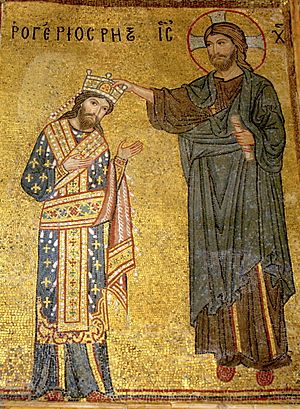
The Normans brought big changes to Sicily in religion, language, and population. As soon as Roger I controlled much of the island, he encouraged people to move there from Northern Europe, France, England, and Northern Italy. Most of these newcomers were Lombards from the Kingdom of Italy. They spoke a form of Latin and supported the Western Christian church. Over time, Sicily became mostly Roman Catholic, and a new Latin-based language developed on the island.
Palermo remained the capital under the Hauteville rulers. Roger's son, Roger II of Sicily, managed to make Sicily, along with Malta and Southern Italy, into a kingdom in 1130. During this time, the Kingdom of Sicily was very rich and powerful, even wealthier than England.
The Norman kings of Sicily mostly relied on the local Sicilian people for important government jobs. At first, Greek, Arabic, and Latin were used for official business, while Norman was spoken at the royal court. Many immigrants arrived during this period, and the island eventually became Latin-speaking. The church also became fully Roman Catholic, whereas before it had been more Eastern Christian under the Byzantines.
Roger II's grandson, William II of Sicily (also known as William the Good), ruled from 1166 to 1189. His greatest achievement was building the Cathedral of Monreale, a beautiful example of Norman architecture in Sicily.
When William died in 1189 without a child, the Hauteville family's rule ended. Roger II's daughter, Constance of Sicily, had married Henry, who was the son of Emperor Frederick I. This meant the crown now belonged to Henry. However, the local nobles chose Tancred of Sicily, an illegitimate grandson of Roger II, to be king.
Hohenstaufen Rule (1194–1266)
Tancred died in 1194. Henry VI and Constance then traveled to Sicily to claim their crown. Henry entered Palermo with a large army without a fight. This ended the Norman Hauteville dynasty, replaced by the German Hohenstaufen family. As Henry VI was being crowned King of Sicily, Constance gave birth to Frederick II.
Frederick grew up in Palermo. Like his grandfather Roger II, he loved science, learning, and books. He started one of Europe's first universities in Naples. He also wrote a book about falconry based on scientific observation. He made important law changes, separating church and state and applying fair justice to everyone. He also supported the Sicilian School of poetry, which was the first time an Italian form of Latin was used for literature.
Frederick II introduced harsh rules against Muslims in Sicily to please the Popes. This led to a rebellion by Sicily's Muslims. In 1224, Frederick II moved the remaining Muslims from Sicily to Lucera in mainland Italy.
Frederick was followed by his son Conrad, and then by his illegitimate son, Manfred. The Hohenstaufen kings of Sicily often kept a group of Saracen (Muslim) soldiers as their personal guard. This practice, among others, caused ongoing tension between the Pope and the Hohenstaufens. Hohenstaufen rule ended when Manfred was killed in the battle of Benevento in 1266.
Late Middle Ages
Angevins and the Sicilian Vespers
During Frederick's rule, there was a lot of tension between the Kingdom and the Pope. This tension continued against Manfred. In 1266, Charles I, Duke of Anjou, with the Pope's support, led an army against the Kingdom. Manfred was killed in battle, and Charles was crowned King of Sicily.
People grew unhappy with French officials and high taxes. This led to a rebellion in 1282 called the Sicilian Vespers. The rebellion was successful with the help of Peter III of Aragon. Peter III had married Manfred's daughter, Constance, which is why the Sicilian nobles invited him. This victory split the Kingdom into two parts. Charles continued to rule the mainland part, also called the Kingdom of Sicily.
The war that followed, the War of the Sicilian Vespers, lasted until 1302. With two kings claiming to be King of Sicily, the island kingdom became known as the Kingdom of Trinacria. This split eventually led to the creation of the Kingdom of the Two Sicilies much later.
Aragonese Period
Peter III's son, Frederick III of Sicily, ruled from 1298 to 1337. For the entire 14th century, Sicily was mostly an independent kingdom. It was ruled by relatives of the kings of Aragon, but they acted as Sicilian kings. The Sicilian parliament, which had existed for a century, continued to have broad powers.
During this time, a sense of a Sicilian people and nation began to form. People were no longer divided into Greek, Arab, and Latin groups. Catalan and Aragonese were spoken at the royal court, while Sicilian was the language of the parliament and common people. This continued until 1409. Because the Sicilian line of the Aragonese family ended, the Sicilian throne became part of the Crown of Aragon.
The island's first university was founded in Catania in 1434. Antonello da Messina was Sicily's greatest artist from this period.
Spanish Period
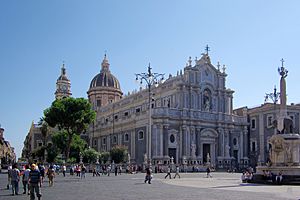
When the crowns of Castile and Aragon united in 1479, Sicily was ruled directly by the kings of Spain. They governed through officials called viceroys. Over the next centuries, power on the island became held by a small number of local nobles.
The viceroy faced challenges due to the distance and poor communication with the royal court in Madrid. It was hard for Spanish viceroys to meet the king's demands and also satisfy the Sicilians. The viceroys tried to keep control by giving out jobs and grants in the king's name. However, the king also used royal councils and other groups, like the Inquisition, to exercise power. Local power was often unclear, and different groups competed, sometimes making Sicily hard to govern.
The 16th century was a great time for Sicily's wheat exports. Economic and social changes came with rising prices, fast population growth, and international trade. In the 17th century, Sicily's silk exports became more important than wheat. From 1590 to 1650, feudal nobles created new settlements and farms, moving people from larger towns back to the countryside.
The nobles used the growing population and demand to build new estates, mostly for wheat. The new villages were mainly for landless workers. Building these estates helped many families gain social and political importance. Townspeople at first welcomed this as a way to help poverty, but it also reduced their control over the countryside.
Sicily suffered a terrible outbreak of the bubonic plague in 1656. This was followed by a damaging earthquake in the east of the island in 1693. Sicily was also often attacked by pirates from North Africa. The rebuilding after these events created a special building style known as Sicilian Baroque. Sicily was briefly ruled by the House of Savoy (1713–1720) and then the Austrian Habsburgs. In 1735, it united with the Bourbon-ruled Kingdom of Sicily under Don Carlos of Bourbon (later Charles III of Spain).
Bourbon Period
British Influence and the Kingdom of the Two Sicilies
The Bourbon kings usually lived in Naples. However, during the Napoleonic Wars (1806-1815), the royal family lived in Palermo. Sicilian nobles welcomed British military help during this time. A new constitution was created for Sicily, based on the British system, with a two-chamber parliament. This parliament ended feudalism in the Kingdom.
The British wanted to keep the Kingdom of Sicily safe to protect their trade routes in the Mediterranean from the French. They sent troops to Sicily and built strong forts around Messina.
The Kingdoms of Naples and Sicily officially joined in 1816. They formed the Kingdom of the Two Sicilies under Ferdinand I. When Ferdinand II became king in 1830, Sicilians hoped the island would regain its independence. They also hoped problems like poverty and unfair justice would be fixed.
The government in Naples saw Sicily's problems as only administrative, meaning they thought existing systems just needed to work better. They were not interested in big changes. Ferdinand's failure led to disappointment and a revolt in 1837. This was mainly because he did not try to get support from the Sicilian middle class, who could have helped him against the powerful nobles.
Growing unhappiness with Bourbon rule and hopes for Sicilian independence led to major revolts in 1820 and 1848. These were against the Bourbons' refusal to allow a constitutional government. The 1848 revolution led to Sicily being independent from the Bourbons for sixteen months. But on May 15, 1849, the Bourbon army took back control of the island. The city of Messina often supported independence. Its leaders came from various groups, including workers, students, and clergy.
The unrest in 1847-48 had wide support in Messina. It created an organized effort and a feeling that the struggle needed to include all of Sicily. The rebels briefly controlled the city. But despite strong resistance, the Bourbon army won and stopped the revolt. This led to more oppression. It also caused many Sicilian revolutionaries to leave Sicily. The bombings of Messina and Palermo earned Ferdinand II the nickname "King Bomba."
Modern Era
Unification of Italy
Sicily joined the Kingdom of Sardinia in 1860. This happened after the expedition of Giuseppe Garibaldi's Mille (Thousand). After Garibaldi's temporary rule, the joining was approved by a public vote. The Kingdom of Sardinia became the Kingdom of Italy in 1861, as part of the Italian Risorgimento (unification).
However, local leaders across the island often stopped the national government's efforts to modernize the economy and political system. For example, they blocked government attempts to set up new town councils, police forces, and a fair justice system. Also, repeated revolts showed that peasants were unhappy.
In 1866, Palermo rebelled against Italy. The Italian navy bombed the city. Italian soldiers quickly executed the civilian rebels and took control of the island again. A limited but long-lasting guerrilla fight against the new Italian government (1861–1871) took place across southern Italy, including Sicily. The Italian government responded with harsh military action. These revolts were not well organized. The government called the rebels "brigands." Sicily and southern Italy were under military rule for several years. The Italian army executed thousands of people, imprisoned tens of thousands, destroyed villages, and moved people away.
Emigration
The Sicilian economy did not easily adapt to unification. Competition from northern industries made it almost impossible to build factories in the South. While many people suffered from new taxes and military service, the Sicilian economy struggled. This led to a huge wave of people leaving the island.
Sicilian men often did not want women to work for pay, so women usually stayed at home. Despite these limits, women played important roles in feeding their families, choosing wives for their sons, and helping their husbands in the fields.
Between 1889 and 1894, there were labor protests by a group called Fasci Siciliani (Sicilian Workers Leagues). Landowners asked the government to step in. Prime Minister Francesco Crispi declared a state of emergency and broke up the organizations. Stopping these strikes also led to more people leaving Sicily.
The Mafia
Ongoing government neglect in the late 19th century allowed criminal groups, known as Cosa Nostra, to grow. The Mafia became an important part of the social structure because the Italian state could not fully control law and order in this distant region. As old feudal systems declined, a new group of violent peasant leaders emerged. They made money from selling land and created a system where people depended on them. The government had to work with these "bourgeois mafiosi," who used violence to enforce their own rules and acted as go-betweens for society and the state.

Early 20th Century and Fascist Period
The Sicilian mafia during the fascism was fought by the government of Benito Mussolini. He sent a special official, Cesare Mori, to the island in 1924. The Mafia slowly spread its influence across many parts of the island. Many Mafia members also moved to other countries, especially the United States. After Mussolini came to power in the 1920s, he strongly cracked down on organized crime. However, the Mafia quickly recovered after the Allied invasion of Sicily in July 1943 during World War II. The Allies mistakenly freed imprisoned Mafia leaders, thinking they were political prisoners.
Although Sicily fell to the Allied armies with little fighting, the German and Italian forces mostly escaped to the mainland. Controlling Sicily gave the Allies a base to move north through Italy. It also provided valuable practice for large-scale amphibious military operations. These lessons were very important for the invasion of Normandy.
Post-War Period
After some political movements for Sicilian independence, Sicily became an autonomous region in 1946. It received its own special rules under the new Italian constitution, with its own parliament and elected president.
The large feudal farms (latifundia) were ended by major land reforms between 1950 and 1962. These reforms created smaller farms and were funded by the Italian government's development fund for the South. Cosa Nostra remained a secret criminal organization with a state-like structure until the 1970s. It used violence to control people and punished members who broke its rules. It also punished outsiders who threatened the organization. The 1960s Sicilian Mafia trials happened because of a rise in organized crime violence around the late 1950s and early 1960s.
In 1984, the Italian government started a policy to fight the Mafia. They tried to get rid of the organization by putting its leaders on trial. The early 1990s saw the tragic deaths of Giovanni Falcone and Paolo Borsellino, who were anti-Mafia judges. Their deaths caused a big change in Italian politics.
In recent years, Sicily has become a place where migrants from Africa, the Middle East, and Bangladesh arrive. They are often on their way to other European countries like Germany, Northern Italy, France, and Sweden.
See also
 In Spanish: Historia de Sicilia para niños
In Spanish: Historia de Sicilia para niños


